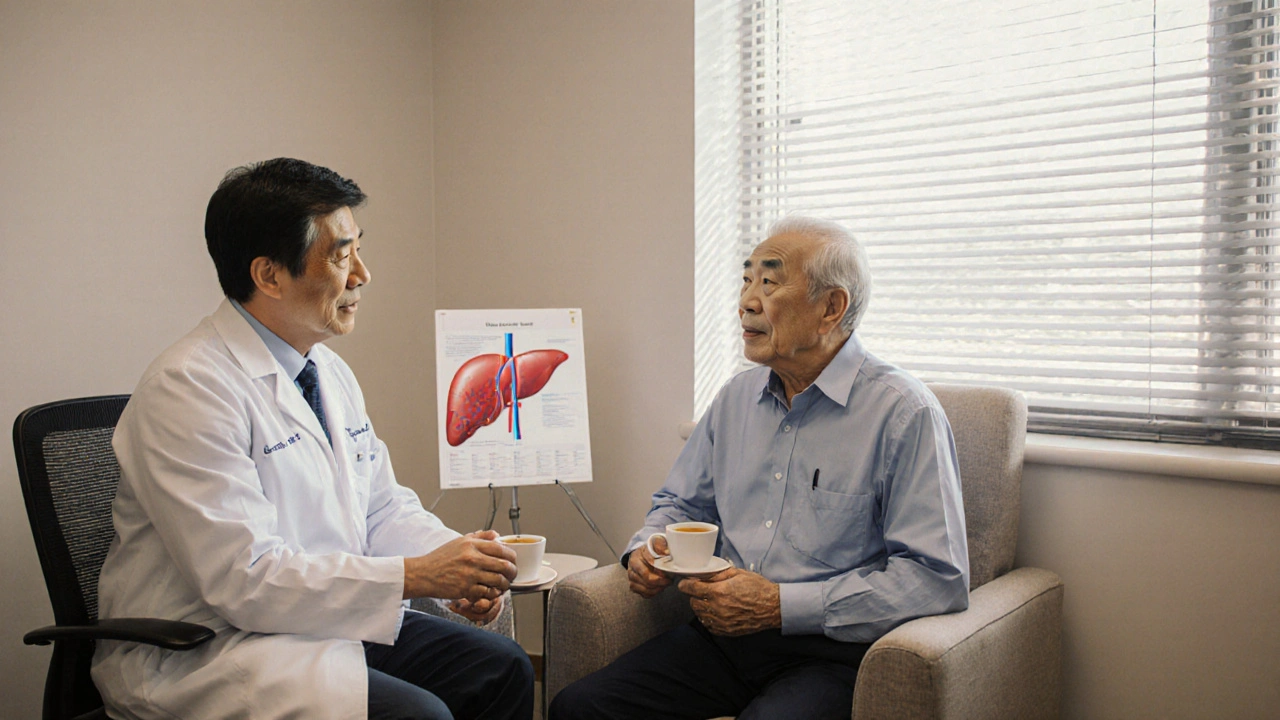Chronic Hepatitis B is a long‑lasting infection caused by the Hepatitis B virus (HBV) that can lead to cirrhosis, liver cancer, and premature death, especially in people over 60. As the population ages, clinicians and families need a clear roadmap for spotting the disease early, navigating treatment, and handling the extra health challenges that come with senior years. This guide pulls together the latest guidelines, real‑world data, and practical tips so you can make informed decisions without wading through medical jargon.
Why Age Changes the Game
Older adults experience immune senescence, a gradual decline in immune function that makes it harder to control HBV replication. Studies from the UK and Asia show that patients over 65 are twice as likely to develop cirrhosis within five years compared to younger adults, even when viral loads are modest. The aging liver also processes drugs less efficiently, raising the stakes for medication‑related side effects. Combined with common co‑morbidities like diabetes, hypertension, and chronic kidney disease, the risk profile for seniors is distinct.
Key Clinical Markers & Diagnostic Tools for Seniors
Diagnosing HBV in an older person starts with serology, but the interpretation of results must account for age‑related changes in liver enzymes and fibrosis.
- HBsAg (hepatitis B surface antigen) remains the primary screening marker. Persistent positivity for six months confirms chronic infection.
- ALT (alanine aminotransferase) levels may stay within normal limits in older patients even when liver damage is progressing, so clinicians rely on additional tools.
- FibroScan (transient elastography) offers a non‑invasive way to measure liver stiffness. A cutoff of≥8kPa in patients over 60 typically signals significant fibrosis, prompting closer monitoring.
- Quantitative HBV DNA testing helps gauge viral activity. In seniors, a threshold of20,000IU/mL is often used to trigger treatment consideration, aligning with NICE guidance.
- Additional markers such as HBeAg and anti‑HBc IgG give clues about viral replication phase and immune tolerance.
Regular assessment every six months-combining serology, liver enzymes, and FibroScan-offers the best chance to catch progression early.
Antiviral Treatment Options for Seniors
Two nucleos(t)ide analogues dominate modern therapy: Tenofovir disoproxil fumarate (TDF) and Entecavir. Both have high barriers to resistance, but they differ in renal safety, bone health impact, and dosing convenience-critical factors for older adults.
| Attribute | Tenofovir (TDF) | Entecavir |
|---|---|---|
| Resistance (5‑year data) | ≤0.5% | ≈1% |
| Renal safety | Potential eGFR decline≥10mL/min/1.73m² in 12% of seniors | Minimal impact; renal monitoring optional |
| Bone health | 10% risk of decreased BMD; consider switching to Tenofovir alafenamide (TAF) if fracture risk is high | No documented BMD loss |
| Dosing | Once daily, 300mg | Once daily, 0.5mg (≤65kg) or 1mg (>65kg) |
| Drug‑drug interactions | Minimal; watch for concurrent nephrotoxic agents | Low; monitor with cytochrome‑P450 substrates |
For most patients over 70 with normal kidney function, entecavir is the safer first‑line choice. If a senior has a high viral load (>200,000IU/mL) and a history of prior resistance, tenofovir (or its newer cousin TAF) may be favored, provided renal function is closely tracked.
Managing Co‑Morbidities and Drug Interactions
Older adults rarely face HBV in isolation. Diabetes, cardiovascular disease, and chronic kidney disease each modify treatment decisions.
- Diabetes mellitus can accelerate fibrosis. Metformin, a common first‑line drug, has no known interaction with tenofovir or entecavir, but tight glucose control reduces liver inflammation.
- Statins for hyperlipidaemia are generally safe but may increase the risk of myopathy when combined with high‑dose tenofovir in patients with reduced creatinine clearance.
- Anticoagulants (e.g., warfarin) require INR monitoring; tenofovir can raise INR slightly, so dose adjustments may be needed.
A comprehensive medication review every six months-ideally by a pharmacist or geriatrician-helps avoid adverse events and ensures the antiviral regimen remains the most suitable option.

Screening & Monitoring Recommendations
Guidelines from NICE (UK) and the World Health Organization (WHO) recommend a slightly different cadence for seniors.
- Initial full panel (HBsAg, anti‑HBc, HBeAg, HBV DNA, ALT, FibroScan).
- If ALT<2×ULN and FibroScan<8kPa, repeat testing every 12months.
- When FibroScan≥8kPa or HBV DNA≥20,000IU/mL, start antiviral therapy and monitor ALT and HBV DNA every 3months for the first year.
- After viral suppression (<20IU/mL) for two years, extend monitoring to every 6months.
- Annual ultrasound for hepatocellular carcinoma (HCC) surveillance in patients with cirrhosis or persistent fibrosis≥F3.
These timelines balance the need for vigilance with the reality that frequent clinic visits can be burdensome for older patients.
Lifestyle, Vaccination, and Preventive Care
Even with antiviral therapy, healthy habits reduce liver stress.
- Limit alcohol to ≤14units per week; many seniors find lower limits (<7 units) safer when liver disease is present.
- Adopt a Mediterranean‑style diet rich in omega‑3 fatty acids, whole grains, and leafy greens; observational data link this diet to slower fibrosis progression.
- Stay physically active-light walking or chair‑based strength exercises improve insulin sensitivity and support immune health.
- Vaccinate against hepatitis A and ensure hepatitis B vaccine boosters if anti‑HBs titres fall below 10mIU/mL, especially for household contacts.
Community health services in Bristol and across the UK offer free catch‑up vaccination for at‑risk elders, making it an easy preventive step.
Putting It All Together: A Practical Care Pathway Checklist
Use this quick‑reference list during appointments or at home.
- Confirm chronic HBV status with HBsAg+HBV DNA.
- Assess liver fibrosis via FibroScan; note score.
- Review co‑morbidities (diabetes, CKD, cardiovascular meds).
- Choose antiviral: entecavir for renal safety; tenofovir/TAF for high viral load.
- Set monitoring schedule (ALT, HBV DNA, eGFR every 3‑6months).
- Schedule annual HCC ultrasound if cirrhosis present.
- Implement lifestyle plan: alcohol limit, diet, exercise.
- Update vaccinations (HAV, HBV booster) and document titres.
Following this pathway can dramatically lower the risk of liver complications and keep quality of life high for seniors living with chronic hepatitis B.
Frequently Asked Questions
Can an older adult stop antiviral therapy once the virus is suppressed?
Current guidelines advise lifelong therapy for most seniors because stopping can lead to viral rebound and rapid fibrosis. Only in rare cases of confirmed seroconversion (loss of HBsAg) under strict specialist supervision is discontinuation considered.
Is Tenofovir safe for someone on dialysis?
Standard tenofovir (TDF) is not recommended for patients with eGFR<30mL/min/1.73m². Tenofovir alafenamide (TAF) has a better renal profile and can be used with dose adjustments, but close monitoring remains essential.
How often should a senior get a liver ultrasound?
If cirrhosis or advanced fibrosis (F3‑F4) is present, an ultrasound every 6 months is recommended for early HCC detection. For lower fibrosis stages, annual screening is sufficient.
Do vaccines still work for people over 70?
Yes, but the immune response can be weaker. A double‑dose hepatitis B vaccine series or a booster after checking anti‑HBs titres improves protection. NHS England offers tailored schedules for the over‑70 population.
What signs suggest my liver disease is getting worse?
New or worsening fatigue, abdominal swelling, easy bruising, dark urine, and a rise in ALT/AST beyond twice the normal range are red flags. A sudden jump in FibroScan stiffness (>12kPa) also signals progression and should prompt urgent review.
